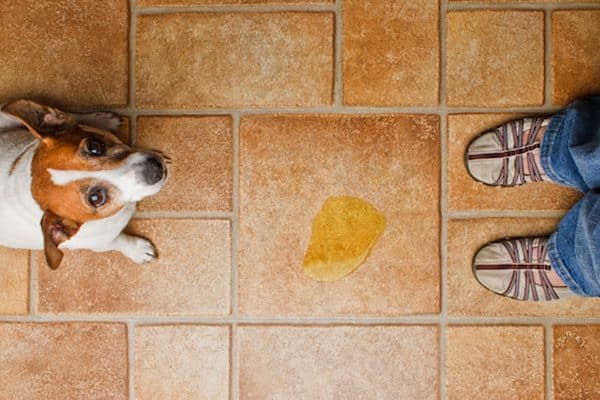If I could list the top five problem canine behaviors that drive dog parents to the brink of despair, scent marking would be high on that list. Even though scent marking is a very normal and common behavior outside, particularly in male dogs, dog marking becomes a big problem when it occurs in the home.
Housetraining accidents are common, too, but unlike scent marking, basic toileting issues can be rectified with a clear, consistent schedule and by following a few housetraining rules. You can tell scent marking from a normal toileting issue by the amount of urine eliminated. Dogs with potty problems usually produce larger amounts of urine than dogs who mark. Scent markers like to deposit little bits of urine in many different places so territory can be well-covered.
Why dog marking happens

Dog marking happens for a variety of different reasons. Photography by Shutterstock.
Dogs mark to advertise their presence or claim territory and resources. Pheromones in urine and feces contain chemical messages that pass on information about the marking dog, such as his age, sex, health and reproductive status. Marking can have a competitive component, but it can also occur if a dog is overstimulated (during or after vigorous play, for example) or if a dog becomes anxious in a particular situation, such as when a person leaves. This common expression of anxiety is often mistaken for spite, resulting in punishment, which only serves to increase anxious behavior.
Both sexes scent mark, but whole males are the worst offenders, as signaling sexual availability and claiming territory is “encouraged” by the presence of testosterone. In many cases, neutering can reduce the desire to scent mark, but some dogs continue even after being neutered. Resources like toys, food bowls, chew treats, bones and beds are the most likely objects to be marked and, in some cases, a dog will mark a person or something that smells heavily of that person, such as a sofa or a bed.
How to stop dog marking
Scent marking is more common in multi-dog and multi-pet households where dogs compete for space, resources and human attention. This is a difficult behavior to work with, but you can make progress with the following tips: „
- Ensure your dog has a full medical checkup so you know his marking is not related to a medical problem. If your dog is given a clean bill of health, then it’s most likely to be behavioral in nature.
- Clean every area your dog has scent marked with a special pet urine cleaner and deodorizer. This gets rid of the enzymes in the urine that smell so good to dogs and encourage them to re-mark on areas they have already visited. „
- Remove high-value resources (like a juicy bone) that encourage competitive marking, and don’t allow your dog or dogs who scent mark to roam freely around your home.
- Take your dog to a dogproofed room or crate when you are unable to supervise him, to prevent access to favorite marking spots.
- Use a leash to tie your dog to you to supervise him constantly when he’s out of his dogproofed area. This can be frustrating for both of you, but it ensures he can’t have any unsupervised accidents.
- Avoid competitive or vigorous play indoors, as excess activity encourages urination. If you see your dog about to mark, interrupt the behavior with a vocal interrupter (like an “Uh Oh!”), immediately directing him onto something more positive or taking him outside.
- Help your dog succeed by taking him to new and different areas on walks. This encourages him to mark outside, rather than inside.
- If you’ve tried everything and your dog still marks, seek help from a veterinarian who might prescribe medication that reduces the desire to mark. You can also buy a belly band for male dogs or doggie diapers for females, and continue with behavioral therapy. The less your home or favorite marking spots smell like urine, the easier for your dog to resist marking over them.
Dogs who urinate when excited or nervous are not marking, so be careful when dealing with this behavior. Elimination can be an expression of anxiety, and punishment will only make the issue worse. In both cases any person coming into your home must give limited attention to your dog until he is calm.
When a calm dog receives attention, there is less chance of him losing control or feeling nervous. When that attention is finally given, the submissive urinator should make his own decision about whether he wants to greet a person, taking pressure off your dog and curbing his need to release urine from stress.
Thumbnail: Photography by Harrison Waters.
Victoria Stilwell, renowned dog trainer, TV personality, author and public speaker, is best known as the star of the hit TV series It’s Me or the Dog, through which she reaches audiences in more than 100 countries. Appearing frequently in the media, she’s widely recognized as a leader in the field of animal behavior, is editor-in-chief of positively.com, CEO of the VSPDT network of licensed trainers and the founder of the Victoria Stilwell Academy for Dog Training & Behavior — the leader in dog trainer education. Connect with her on Facebook and on Twitter at @VictoriaS.
Read more about dog pee on Dogster.com:
- How to Deal With Your Dog Peeing in the House
- What Your Dog’s Pee is Trying to Tell You
- FYI: Dog Pee Has Its Own Microbiome
Plus, read more about dog marking on Whole Dog Journal >>
Editor’s note: This article appeared in Dogster magazine. Have you seen the new Dogster print magazine in stores? Or in the waiting room of your vet’s office? Subscribe now to get Dogster magazine delivered straight to you!
The post How to Stop Dog Marking appeared first on Dogster.
No comments:
Post a Comment